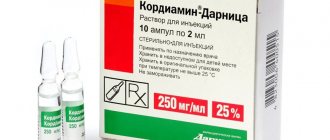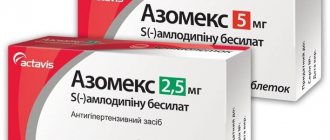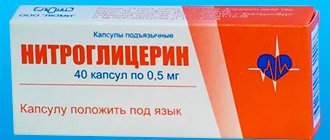Features of the composition and action of Spironolactone
The medicine is prepared in tablets and contains 25 or 100 mg of the active ingredient spironolactone. Additional components of the composition are presented:
- calcium stearate;
- povidone;
- lactose;
- potato starch;
- monohydrate.
Each package of medication contains 20, 30 tablets. Spironolactone is a diuretic that accelerates the elimination of sodium and chlorine from the body, reduces uric acidity, and preserves potassium and magnesium. The therapeutic effect occurs within 2-5 days from the start of administration.
Spironolactone, 50 mg, capsules, 30 pcs.
Inside.
To ensure the dosage regimens indicated below, if it is necessary to use spironolactone at a dose of 25 mg, drugs from other manufacturers should be prescribed in the dosage form of “tablets” or “capsules” at a dosage of 25 mg.
Essential hypertension
The daily dose for adults is usually 50-100 mg once and can be increased to 200 mg, and the dose should be increased gradually, once every 2 weeks. To achieve an adequate response to therapy, the drug must be taken for at least 2 weeks. If necessary, adjust the dose.
Idiopathic hyperaldosteronism
The drug is prescribed at a dose of 100-400 mg/day.
Severe hyperaldosteronism and hypokalemia
The drug is prescribed at a dose of 300 mg/day (maximum 400 mg/day) in 2-3 doses; as the condition improves, the dose is gradually reduced to 25 mg/day.
Hypokalemia and/or hypomagnesemia
For hypokalemia and/or hypomagnesemia caused by diuretic therapy, the drug is prescribed at a dose of 25-100 mg/day, once or in several doses. The maximum daily dose is 400 mg if oral potassium supplements or other methods of replenishing the deficiency are ineffective.
Diagnosis and treatment of primary hyperaldosteronism
As a diagnostic agent for a short diagnostic test: for 4 days, 400 mg/day, divided into several doses per day. If the potassium content in the blood increases while taking the drug and decreases after its discontinuation, the presence of primary hyperaldosteronism can be assumed.
For a long-term diagnostic test: at the same dose for 3-4 weeks. When correction of hypokalemia and arterial hypertension is achieved, the presence of primary hyperaldosteronism can be assumed.
Short course of preoperative therapy for primary hyperaldosteronism
After the diagnosis of hyperaldosteronism has been established using more accurate diagnostic methods, the drug SPIRONOLACTONE should be taken at a dose of 100-400 mg / day, divided into 1-4 doses per day during the entire period of preparation for surgery.
If surgery is not indicated, then SPIRONOLACTONE is used for long-term maintenance therapy, using the lowest effective dose, which is selected individually for each patient.
Edema due to nephrotic syndrome
The daily dose for adults is usually 100-200 mg/day. No effect of spironolactone on the underlying pathological process has been identified, and therefore the use of this drug is recommended only in cases where other types of therapy are ineffective.
Edema syndrome due to chronic heart failure
Daily, for 5 days, 100-200 mg/day in 2-3 divided doses, in combination with a loop or thiazide diuretic. Depending on the effect, the daily dose is reduced to 25 mg. The maintenance dose is selected individually. Maximum dose 200 mg/day.
Edema due to liver cirrhosis
If the ratio of sodium and potassium ions (Na+/K+) in the urine exceeds 1.0, then the daily dose for adults is usually 100 mg. If the ratio is less than 1.0, then the daily dose for adults is usually 200-400 mg. The maintenance dose is selected individually.
Edema in children
The initial dose in children over 3 years of age is 1.0-3.3 mg/kg body weight or 30-90 mg/m2/day in 1-4 doses. After 5 days, the dose is adjusted and, if necessary, increased by 3 times compared to the original.
Use in elderly patients
It is recommended to start treatment with the minimum dose and titrate it to achieve the maximum required dose under monitoring of liver/renal function.
Indications and contraindications
The instructions recommend the use of Spironolactone for the following pathologies:
- with premenstrual, nephrotic syndrome;
- Conn's syndrome, polycystic ovaries;
- increased blood pressure;
- swelling that occurs in the second half of pregnancy or with CHF;
- cirrhosis of the liver.
The medication is contraindicated:
- in case of individual intolerance to the component composition;
- menstrual irregularities;
- the first three months of gestation;
- unstable acid-base balance;
- diabetic glomerulosclerosis;
- diabetes mellitus, chronic renal failure;
- liver dysfunction, in the absence of urine entering the bladder;
- low sodium concentration in the blood;
- increased levels of calcium and potassium.
The drug is prohibited for patients with Addison's disease.
Spironolactone
Inside.
To ensure the dosage regimens indicated below, if it is necessary to use spironolactone at a dose of 25 mg, drugs from other manufacturers should be prescribed in the dosage form of “tablets” or “capsules” at a dosage of 25 mg.
Essential hypertension
The daily dose for adults is usually 50-100 mg once and can be increased to 200 mg, and the dose should be increased gradually, once every 2 weeks. To achieve an adequate response to therapy, the drug must be taken for at least 2 weeks. If necessary, adjust the dose.
Idiopathic hyperaldosteronism
The drug is prescribed at a dose of 100-400 mg/day.
Severe hyperaldosteronism and hypokalemia
The drug is prescribed at a dose of 300 mg/day (maximum 400 mg/day) in 2-3 doses; as the condition improves, the dose is gradually reduced to 25 mg/day.
Hypokalemia and/or hypomagnesemia
For hypokalemia and/or hypomagnesemia caused by diuretic therapy, the drug is prescribed at a dose of 25-100 mg/day, once or in several doses. The maximum daily dose is 400 mg if oral potassium supplements or other methods of replenishing the deficiency are ineffective.
Diagnosis and treatment of primary hyperaldosteronism
As a diagnostic tool for a short diagnostic test:
for 4 days, 400 mg/day, divided into several doses per day. If the potassium content in the blood increases while taking the drug and decreases after its discontinuation, the presence of primary hyperaldosteronism can be assumed.
For a long-term diagnostic test:
at the same dose for 3-4 weeks. When correction of hypokalemia and arterial hypertension is achieved, the presence of primary hyperaldosteronism can be assumed.
Short course of preoperative therapy for primary hyperaldosteronism
After the diagnosis of hyperaldosteronism has been established using more accurate diagnostic methods, the drug SPIRONOLACTONE should be taken at a dose of 100-400 mg / day, divided into 1-4 doses per day during the entire period of preparation for surgery.
If surgery is not indicated, then SPIRONOLACTONE is used for long-term maintenance therapy, using the lowest effective dose, which is selected individually for each patient.
Edema due to nephrotic syndrome
The daily dose for adults is usually 100-200 mg/day. No effect of spironolactone on the underlying pathological process has been identified, and therefore the use of this drug is recommended only in cases where other types of therapy are ineffective.
Edema syndrome due to chronic heart failure
Daily, for 5 days, 100-200 mg/day in 2-3 divided doses, in combination with a loop or thiazide diuretic. Depending on the effect, the daily dose is reduced to 25 mg. The maintenance dose is selected individually. Maximum dose 200 mg/day.
Edema due to liver cirrhosis
If the ratio of sodium and potassium ions (Na+/K+) in the urine exceeds 1.0, then the daily dose for adults is usually 100 mg. If the ratio is less than 1.0, then the daily dose for adults is usually 200-400 mg. The maintenance dose is selected individually.
Edema in children
The initial dose in children over 3 years of age is 1.0-3.3 mg/kg body weight or 30-90 mg/m2/day in 1-4 doses. After 5 days, the dose is adjusted and, if necessary, increased by 3 times compared to the original.
Use in elderly patients
It is recommended to start treatment with the minimum dose and titrate it to achieve the maximum required dose under monitoring of liver/renal function.
Adverse reactions to Spironolactone therapy
Therapeutic procedures can cause non-standard effects, manifested by:
- muscle spasms, decreased potency levels;
- allergies with obsessive itching, medicinal and nettle fever, skin rashes;
- carcinoma and painful sensations in the mammary glands, rough voice;
- absence of menstruation or recurring discomfort with each menstruation;
- excessive hair growth, enlarged mammary glands;
- bloody discharge during menopause;
- dyspepsia, intestinal colic, hemorrhages in the gastrointestinal tract;
- gastritis, stomach ulcers, pain in the abdominal area;
- attacks of nausea with vomiting, headache;
- drowsiness, dizziness, lethargy;
- movement coordination disorder, lethargy;
- an increase in alkali and urea levels in the bloodstream.
In laboratory diagnostics, adverse reactions are manifested by a decrease in the number of neutrophils, deficiency of folic acid, and platelets.
The nuances of Spironolactone therapy
The tablets are taken once a day with food. Dosages for adults are prescribed in the instructions for the drug:
- for congestive heart failure with edema - 100 mg once, then the dose is adjusted depending on the body's reaction to 25-200 mg per day;
- severe heart failure - 25 mg per day, if well tolerated - up to 50 mg per day;
- ascites and edema due to liver cirrhosis - from 200 to 400 mg daily;
- malignant form of ascites - from 100 to 200 mg, then the volume gradually increases to 400 mg daily;
- nephrotic syndrome - from 100 to 200 mg per day.
Elderly patients are prescribed minimum dosages, which are gradually increased until the expected effect is achieved. Particular caution is required when treating patients with complex renal or hepatic insufficiency that can alter the metabolism of medications.
For children, the initial dosage is 3 mg per kilogram of weight. Dose adjustment is carried out according to the tolerability of Spironolactone. For children, it is possible to create a suspension from crushed tablets and water.
Publications in the media
(Spironolactonum) INN
Synonyms. Aldakton, Veroshpiron.
Composition and release form. Spironolactone tablets 0.025 g.
Indications. Edema caused by heart failure, liver cirrhosis, nephrotic syndrome; swelling caused by the use of corticosteroids, estrogens; idiopathic edema; hypertonic disease; hypokalemia.
Pharmachologic effect. Spironolactone is a potassium-sparing diuretic, and its diuretic effect is associated with aldosterone antagonism, that is, it competitively inhibits the action of aldosterone. The drug acts on the distal tubules of the nephron, increasing the excretion of sodium and water, but decreasing the excretion of potassium and urea. Spironolactone has been successfully used as an antihypertensive agent to treat patients in whom increased aldosterone production predominates (usually in combination with thiazide diuretics).
Pharmacokinetics. Spironolactone is well absorbed from the gastrointestinal tract into the blood, its bioavailability is more than 90%. Eating increases the absorption of spironolactone. The drug is metabolized in the liver with the formation of a pharmacologically active metabolite - canrenone (25-30% of the dose taken). The plasma protein binding of spironolactone and canrenone is very high - more than 90%. T1/2 of spironolactone-canrenone ranges from 13 to 24 hours (average 19 hours) when the drug is taken orally once or twice a day; when taking the drug 4 times a day, T1/2 ranges from 9 to 16 hours (on average 12.5 hours). The time for the onset of a pronounced diuretic effect with repeated administration of the drug is the second or third day. Spironolactone and metabolites are excreted mainly by the kidneys (10% unchanged) and through the gastrointestinal tract.
Side effects. Hyperkalemia, hyponatremia; gynecomastia; drowsiness; skin rash; ataxia; Gastrointestinal irritation (nausea, vomiting, stomach cramps, diarrhea).
Contraindications. Anuria or acute renal failure; diabetes mellitus, diabetic nephropathy; severe liver failure; hyponatremia; hypersensitivity to the drug; incomplete AV heart block; first trimester of pregnancy, menstrual irregularities; enlargement of the mammary glands in men.
Adverse reactions when interacting with other drugs. Spironolactone may increase the half-life of digoxin when taken together; It is recommended to reduce the dose of digoxin with this combination or increase the interval between doses of digoxin. It is not recommended to prescribe spironolactone with drugs that cause gynecomastia.
Information for the patient. Spironolactone is highly soluble in lipids in the presence of bile acids released during food intake, so the drug must be administered after meals. The daily dose varies from 0.05 to 0.3 g, but is usually 0.1-0.2 g (in 2-4 doses). If spironolactone is added to therapy with other diuretics or antihypertensive agents, it is recommended to reduce the doses of all drugs by 50%. Elderly patients have an increased risk of developing hyperkalemia. Missed dose - see hydrochlorothiazide. Patients receiving spironolactone require weight and dietary control, especially control of salt intake. Avoid foods rich in potassium. With long-term treatment with spironolactone in men, enlargement of the mammary glands is possible.
Features of overdose and interaction
Accidental use of large doses of the drug can become a source of:
- dehydration of the body and increase in the amount of urea;
- excess calcium, potassium and lack of sodium;
- skin rashes, diarrhea;
- attacks of dizziness with nausea and vomiting.
Therapeutic measures to relieve intoxication include gastric lavage, restoration of water balance and treatment of high blood pressure. In difficult cases, the patient is prescribed hemodialysis procedures.
The instructions note that combination with certain drugs may change the effectiveness of Spironolactone:
- Gonadorelin, Buserelin, Triptorelin - their effect is enhanced;
- Lithium carbonate – increases the amount of lithium in the bloodstream;
- Cholestyramine – provokes potassium deficiency;
- Eprosartan, Losartan, Candesartan - increases potassium concentration.
Hyperkalemia is observed when combined with potassium-sparing diuretics, table salt substitutes, etc.


